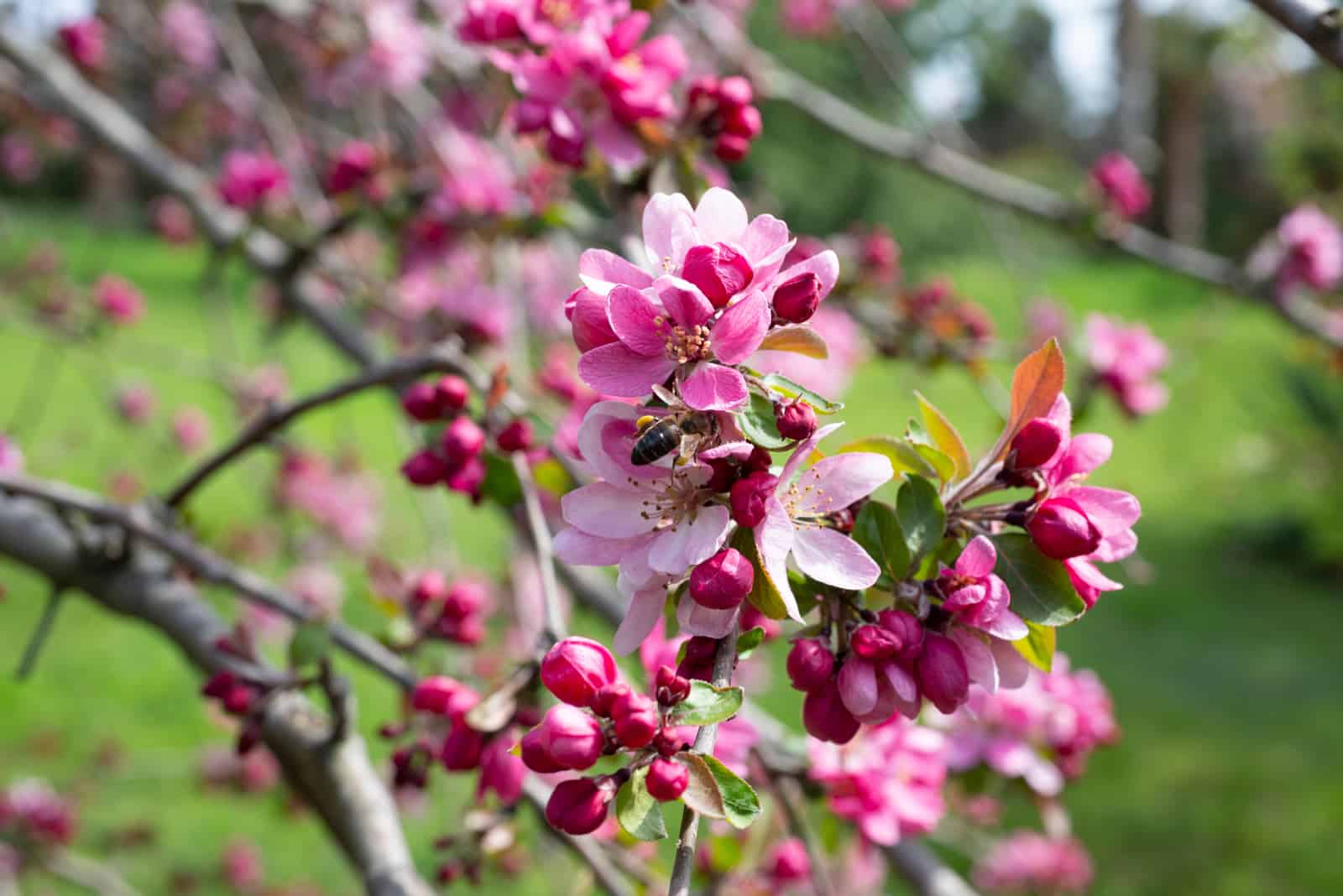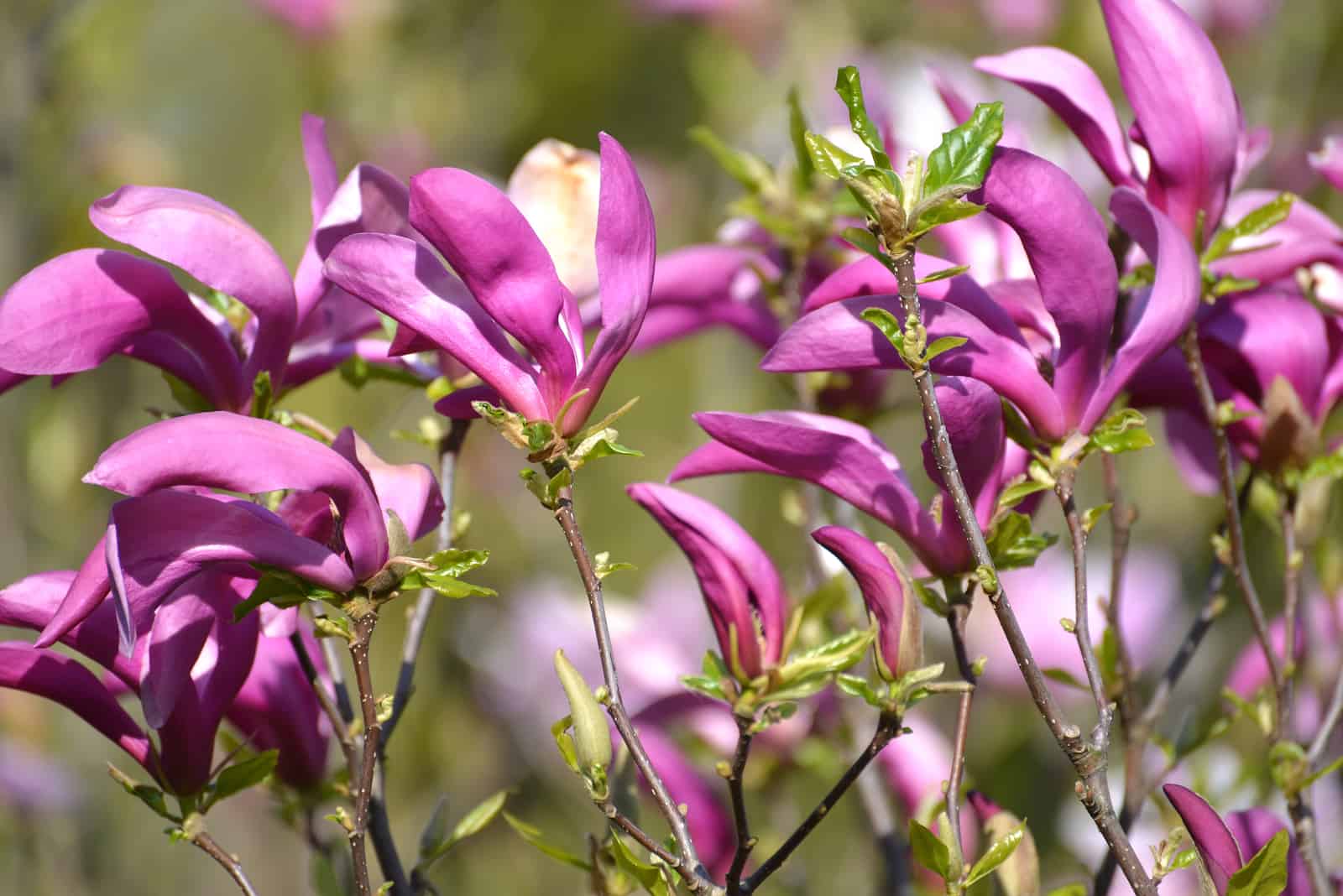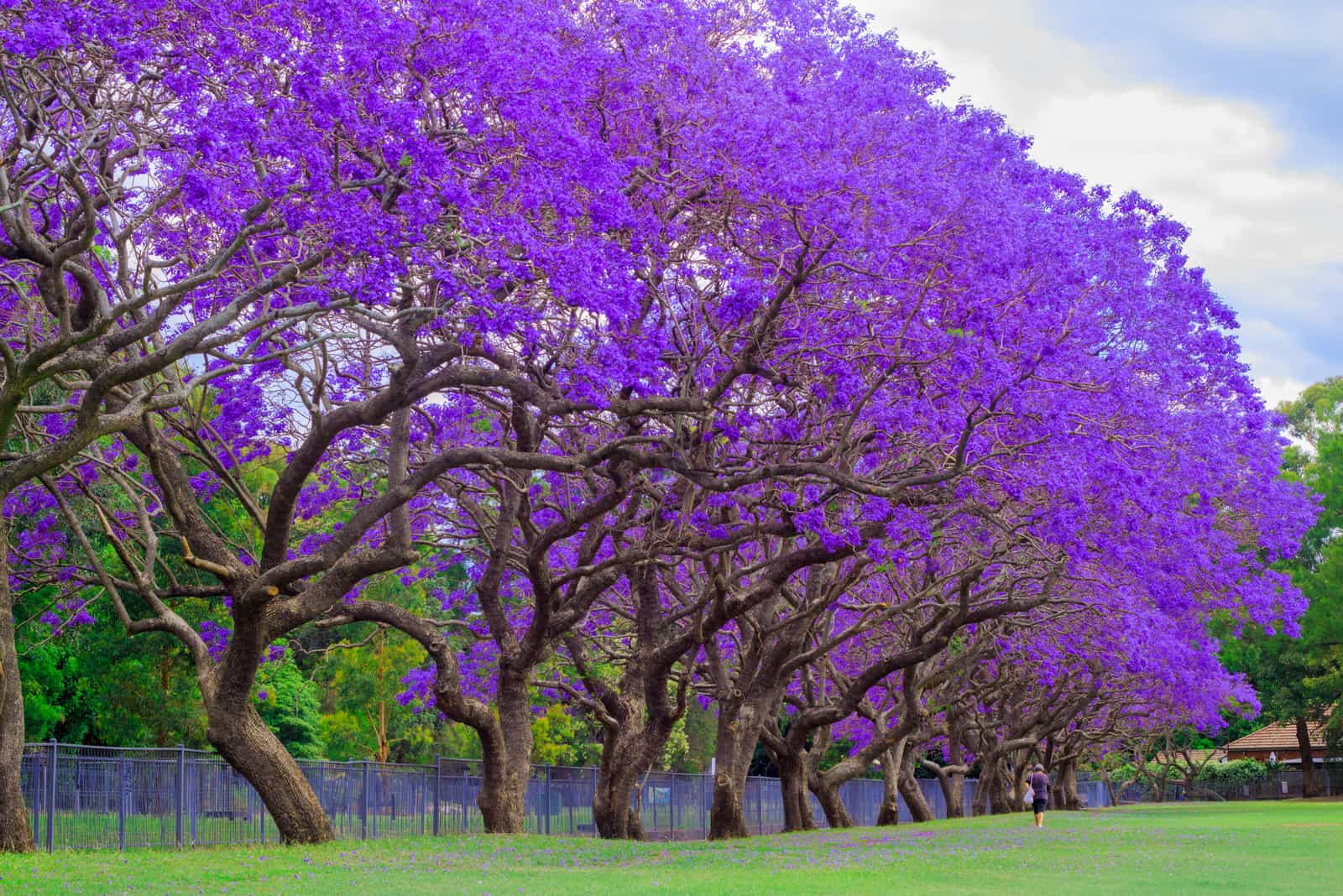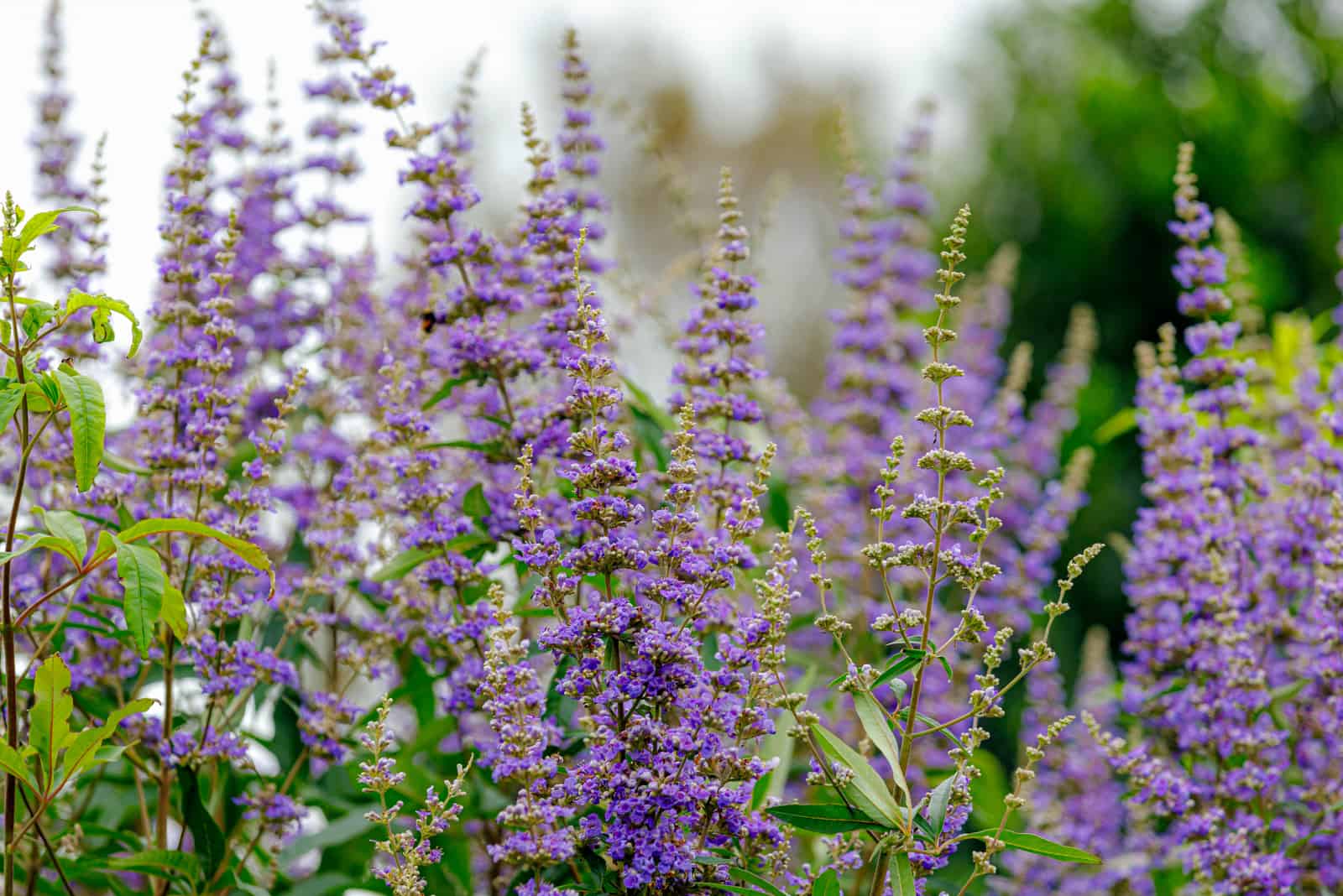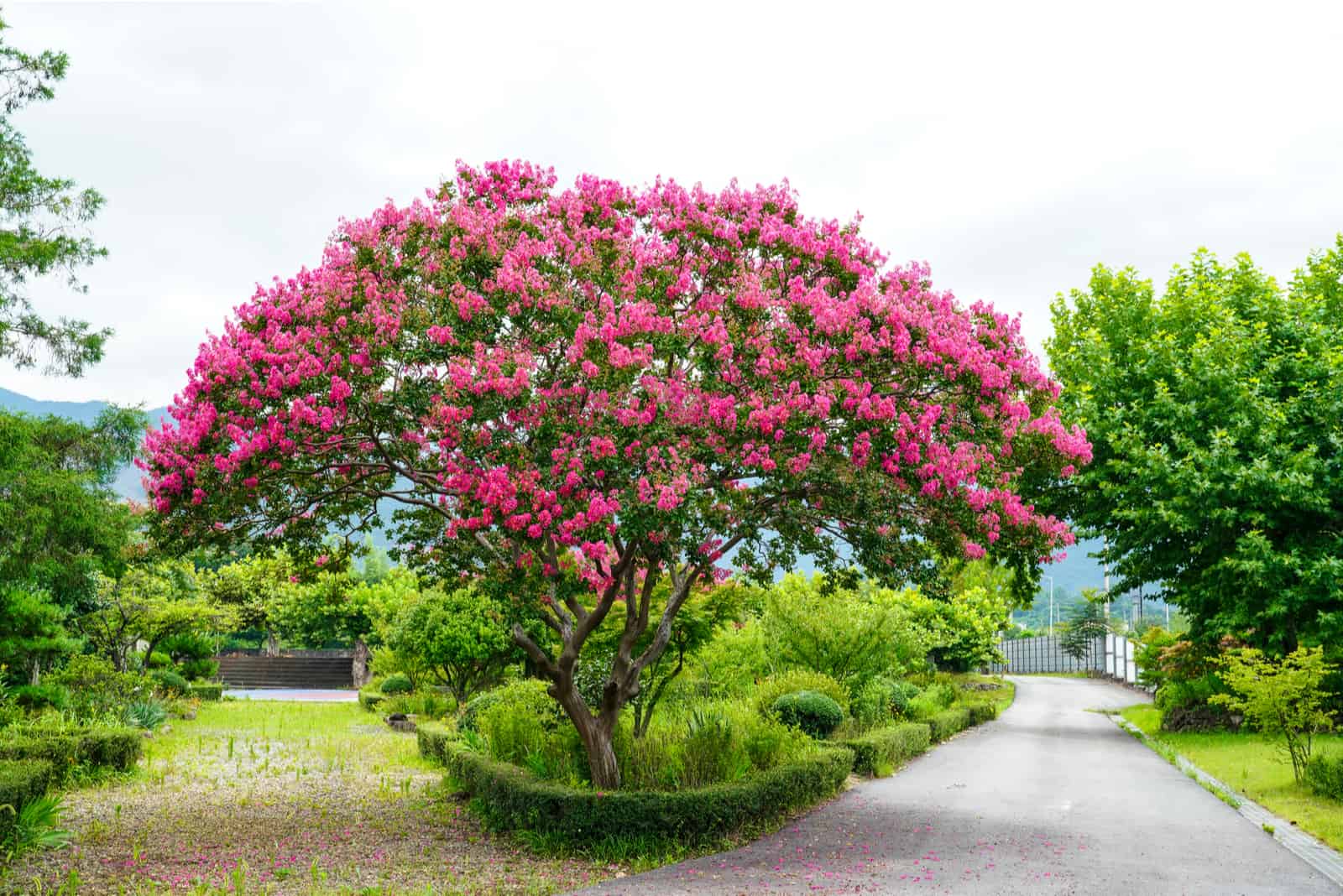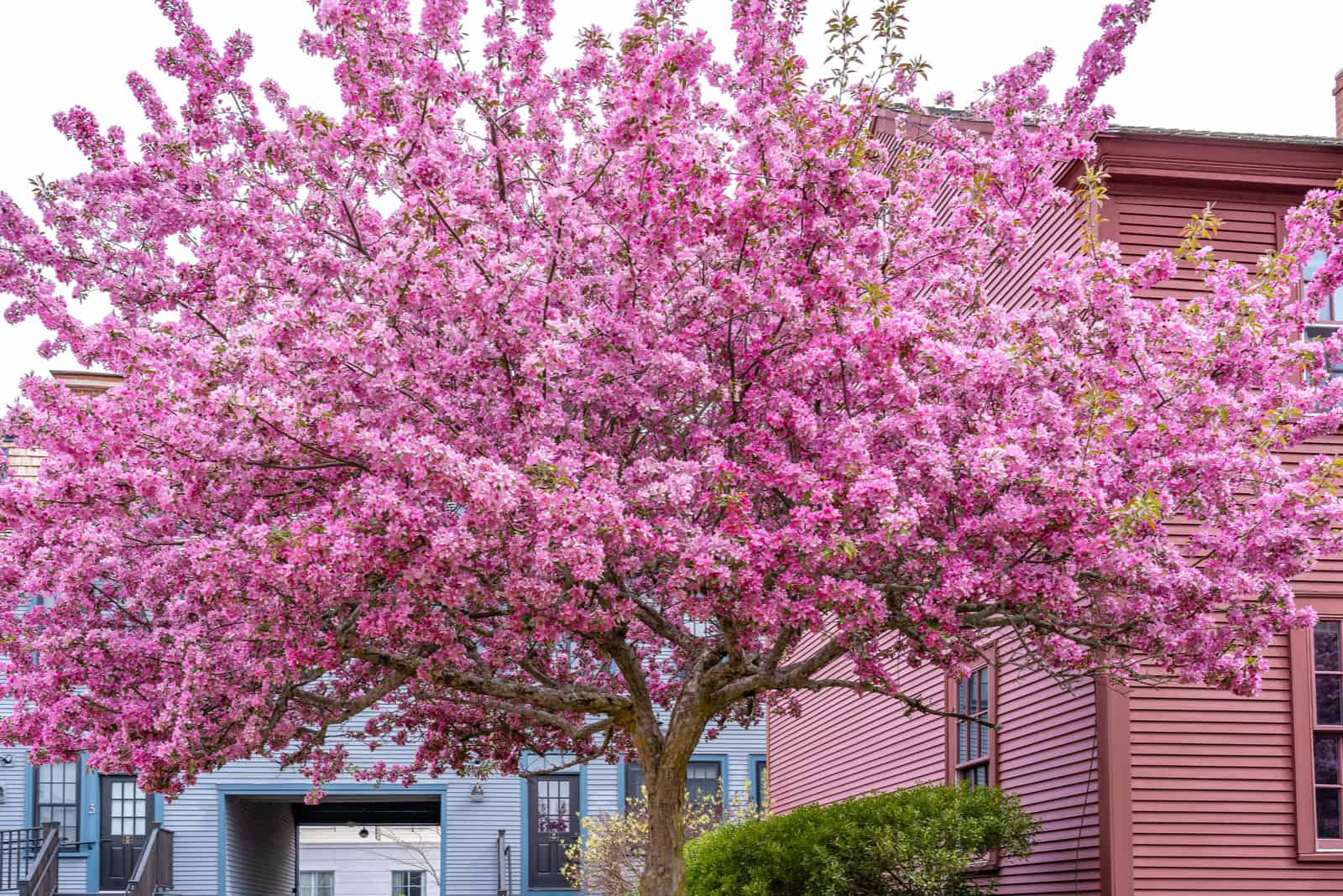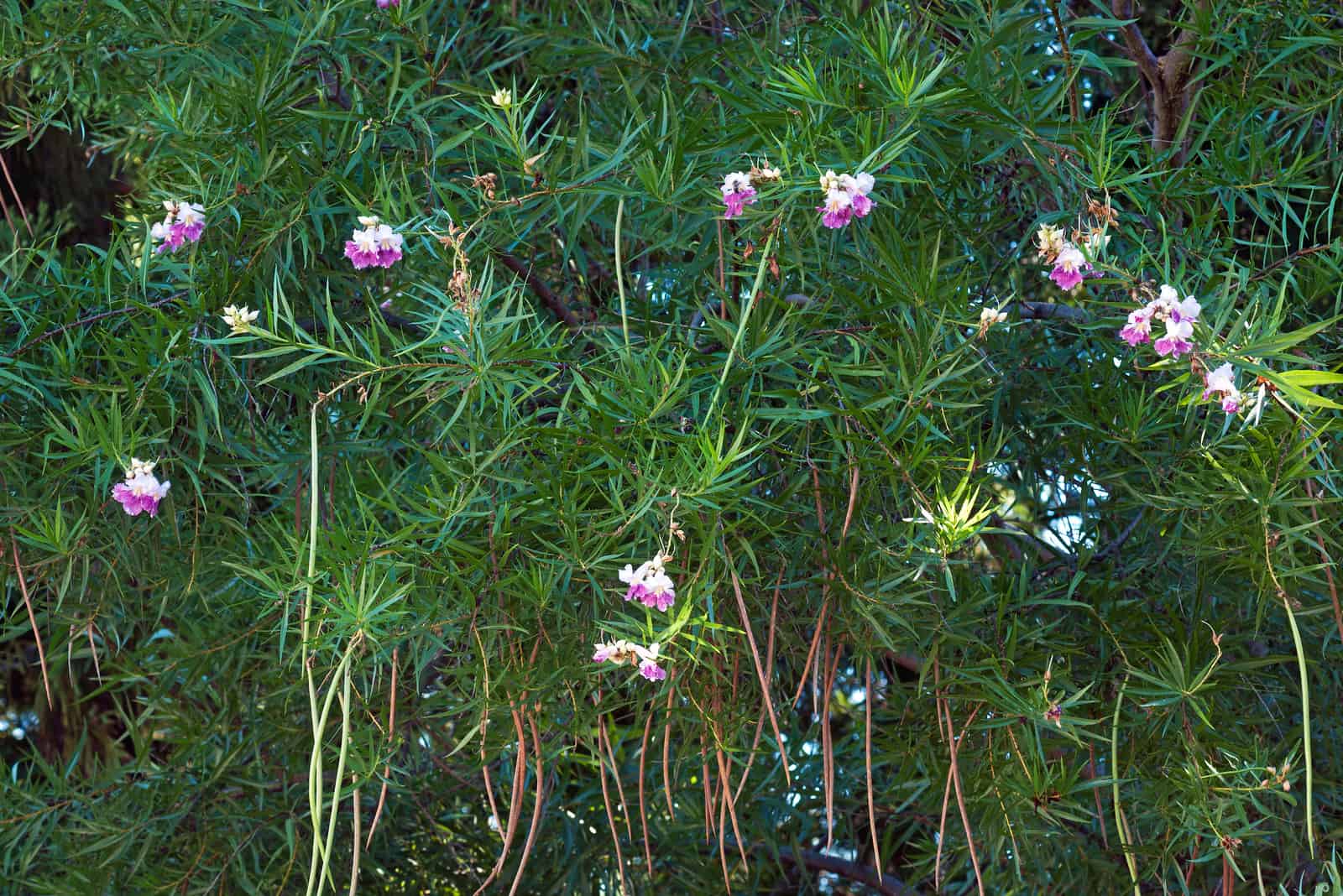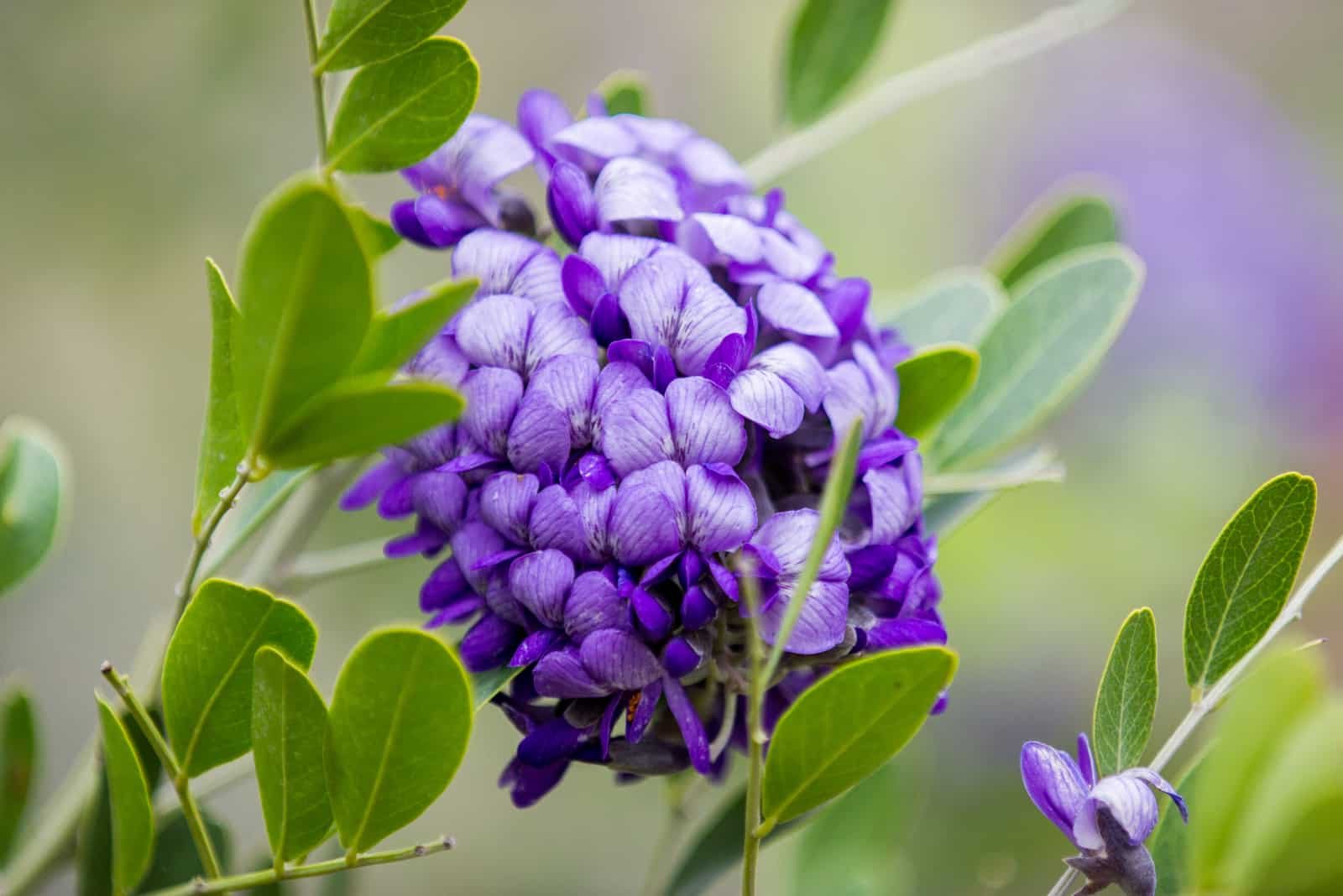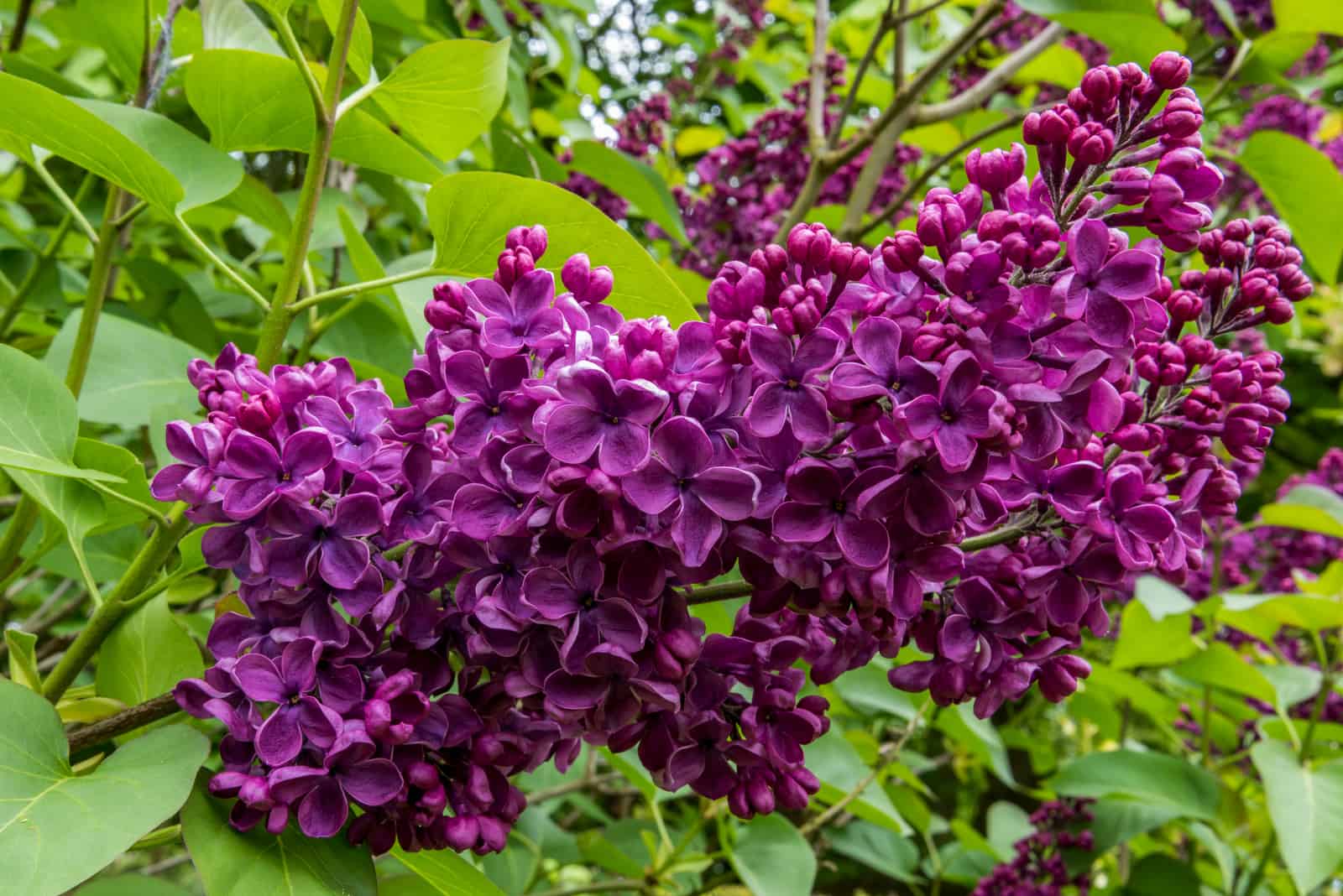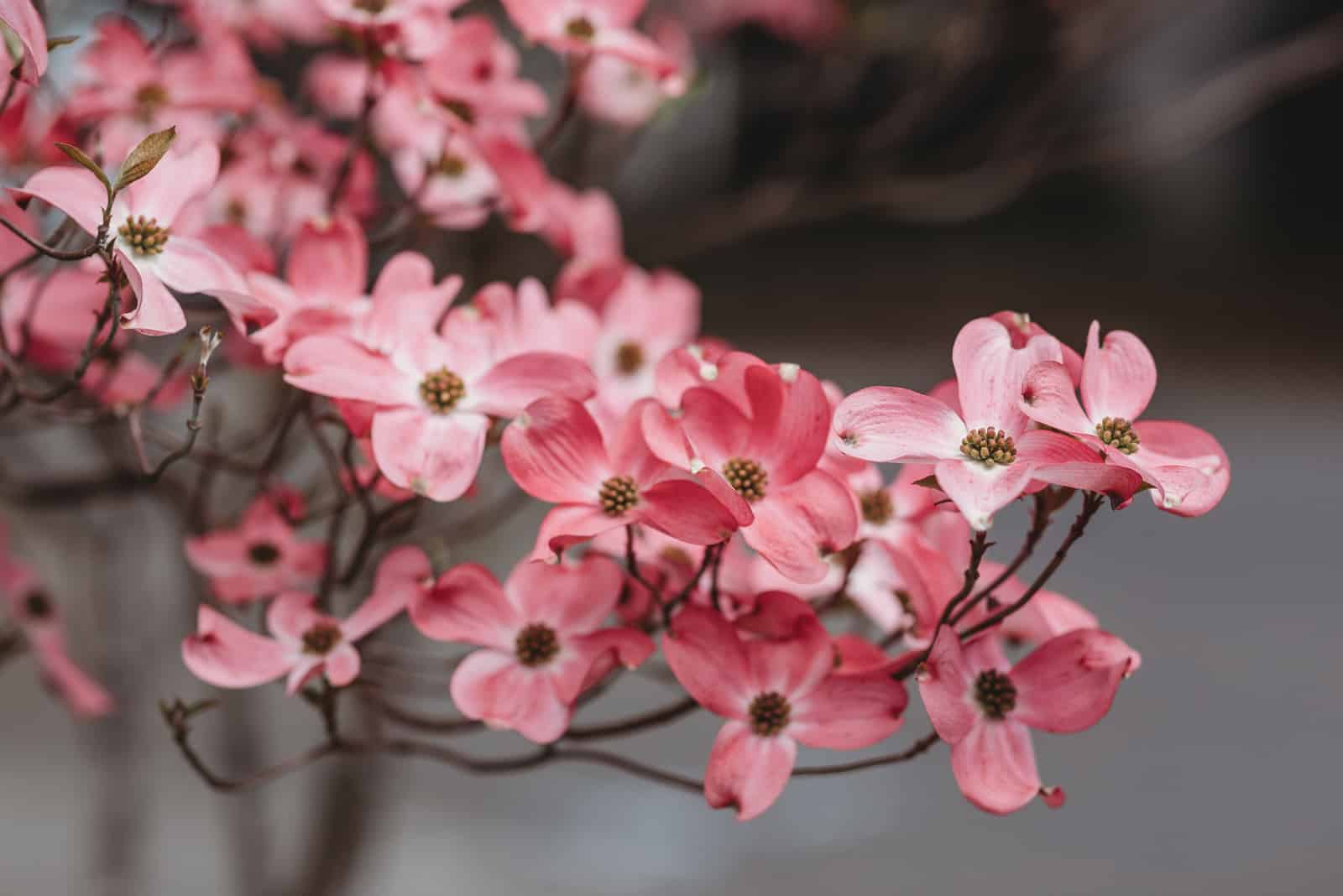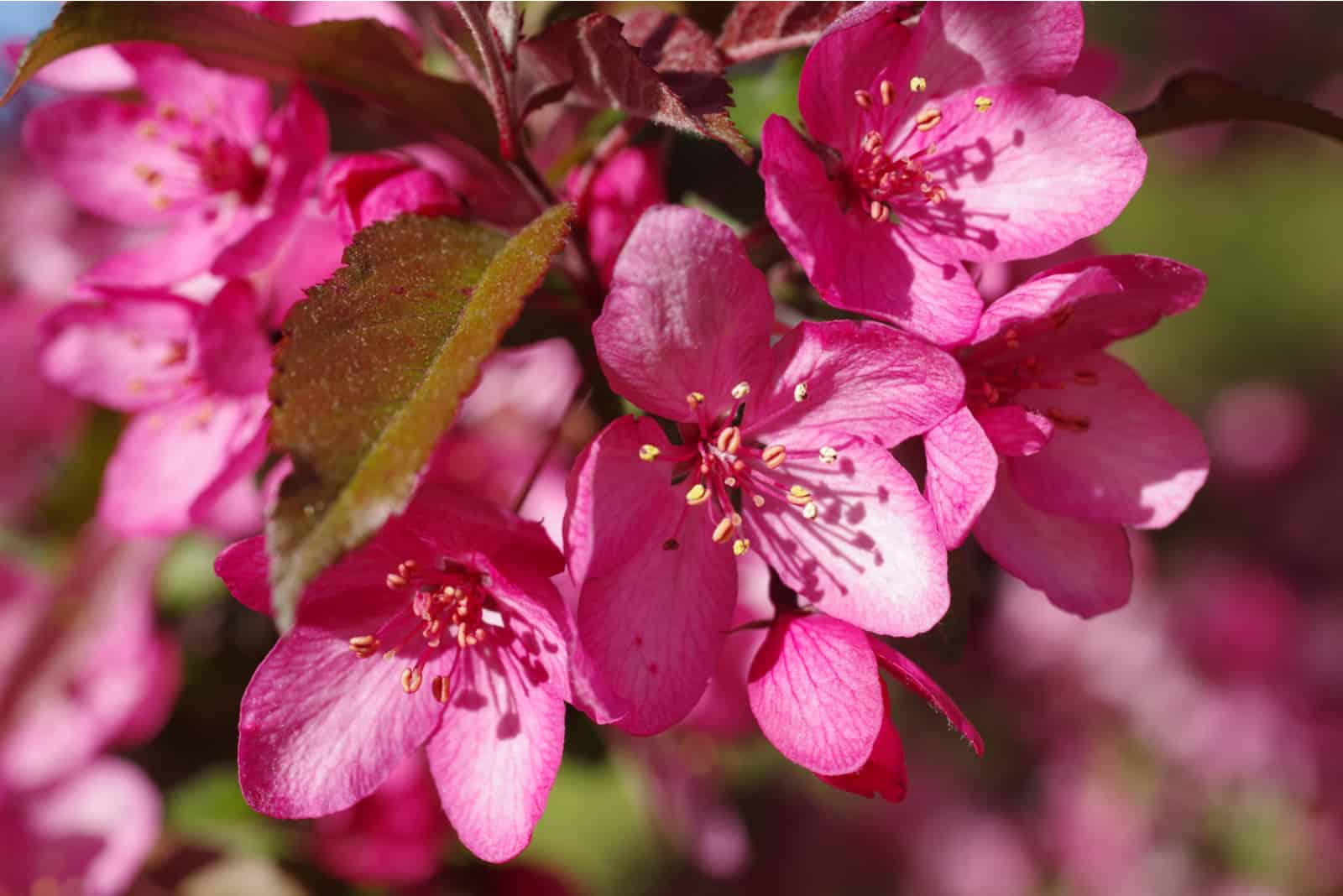Trees with purple flowers are one of the best things about spring. Their relaxing color can only make your day better.
Strolling down the street and admiring these flowering trees or reading a book in their protective embrace, is something we cannot give up.
In this article, you will find ten different trees with purple flowers that you can grow in your front yard.
Your town may not have a Desert willow or American Redbud for you to enjoy, but having one in your garden is even better.
You can read about our favorite trees that flower in spring and learn how to care for them so that you can grow them yourself.
You can also find alternatives that bloom in summer if that is your preference.
Let’s begin, enjoy!!
Trees With Purple Flowers In Spring
Below you will find a list of ten purple flowering trees that bring out the essence of spring.
Their care guides are reasonably simple as they usually don’t require much maintenance. However, you still have to tend to the watering and other needs of these trees, especially when they’re young.
1. Lily Magnolia
The Lily magnolia is a flowering shrub that is everyone’s favorite. You can plant it near your fence so that everyone can experience its grandeur and beauty.
Here is the basic information:
Scientific name: Magnolia liliiflora
Native habitat: native to southwest China, but grown in all of China and Japan for centuries
Growth rate: slow
Size: 8-12 feet (2.4-3.7 m) tall
Since we’re used to growing flowers and small plants, we forget how big trees can get. Magnolia is considered a small tree, and it will perfectly fit your suburban landscape.
Appearance
The Lily magnolia has many common names, including Red magnolia, Tulip magnolia, Japanese magnolia, Purple magnolia, Mulan magnolia, Woody-orchid, and probably many more.
It produces purple or pink flowers in early spring that you can admire for two weeks before they start falling off.
This deciduous shrub is perfect for growing as a patio tree or as a foundation shrub that will accentuate the beauty of your home.
You can grow even more magnolias if you know how to propagate them, and this video helps you accomplish that.
Light Requirements
The Lily magnolia tree requires full sun exposure to produce the brightest flowers. It can tolerate partial shade, but the color of the flowers would be paler.
However, it might actually prefer some shade if the temperatures are scorching.
Water Requirements
Newly planted trees require watering once a week. Established trees older than two years don’t need to be watered more than twice a month.
It’s a low-maintenance plant that doesn’t mind the drought, so long as it is not constant.
Temperature And Humidity
This tree can tolerate freezing temperatures, down to -10 °F (-23 °C), for a short period, but if you don’t protect it in the cold winter months, it can be seriously damaged.
It loves warm temperatures and thrives best in hardiness zones 5-10.
It doesn’t require high humidity, too high can be an issue and even cause fungal diseases such as powdery mildew.
Soil And Fertilizer
The Lily magnolia prefers mildly acidic to neutral substrates rich in nutrients and organic content. The soil also needs to be moderately moist and well-draining, preventing fungal diseases.
You can mulch the roots, which helps retain moisture, so you don’t have to water it too often.
You don’t need to feed your tree with fertilizer immediately after planting. However, when the tree is established, you can give it some slow-release fertilizer every year at the beginning of the season when the flowers begin to develop.
2. Jacaranda Tree
Walking down the tree line of Jacaranda trees is an unforgettable experience. When you see the trees dressed in purple or violet-blue, you will want to plant one in your yard.
Here are the general specifics:
Scientific name: Jacaranda mimosifolia
Native habitat: Bolivia and Argentina
Growth rate: fast-growing
Size: 25-50 feet (7.6-15.2 m) tall
Jacarandas are not enormous but can make you feel like you live in a fairytale when they flower at the same time as your peonies and irises.
Appearance
Its height makes the Jacaranda tree a perfect shade tree, and it also cheers us up with its flowers twice a year, once in late spring or early summer, and then again in fall.
This deciduous, drought-tolerant tree stays in bloom for two months and puts a smile on whoever catches so much as a glimpse of its violet clusters.
Light Requirements
This tree can tolerate some shade, but if you want the best flowers, you should plant it where it can get at least six hours of sunlight a day.
Water Requirements
Water the plant only after the top 3-4 inches (7.6-10 cm) of the topsoil are dry. You should water the Jacaranda tree thoroughly once a week, and if the season is particularly dry or hot, you should increase the watering to two to three times a week, depending on the needs.
Temperature And Humidity
Jacaranda trees cannot be grown where the temperatures are often below zero. The lowest temperature that established trees can shortly tolerate is 19 °F (-7 °C).
Their optimal temperature is between 68 and 86 °F (21.27 °C). Jacaranda trees also love high humidity environments, and the ideal humidity level is 70%.
It is a perfect tree for southern California and Los Angeles, but you can grow it anywhere where the weather is warm and humid.
Soil And Fertilizer
Jacarandas love mildly acidic soils and sandy, well-draining soils. They can also tolerate loam or clay substrates as long as the mixture is well-draining.
Use slow-release, well-balanced fertilizer such as triple 10, once a year. Don’t use fertilizers with high nitrogen levels as they can suppress flowering.
Here’s a short video that helps you grow and care for jacaranda trees so you can enjoy your purple surroundings.
3. Chaste Tree
Chaste trees have many cultivars, all of which are perfect companions to the plants in your flower garden. ‘Montrose purple’ and ‘Texas lilac’ are our favorites because of their captivating color, but you won’t make a mistake if you get a differently-colored chaste tree.
Here is the general information:
Scientific name: Vitex agnus-castus
Native habitat: Mediterranean
Growth rate: fast-growing
Size: 3-20 feet (0,9-6 m), depending on the variety
Appearance
The Chaste tree, with its light purple, white, or pink blossoms and dark green foliage, doesn’t attract only curious glances. Bees and other pollinators are frequently seen near this tree when it produces its flowers from spring to early fall.
It is a deciduous tree with many different names: vitex, monk’s peppers, chaste berry, Abraham balm’s, and lilac chaste tree.
Light Requirements
Like the trees above, the chaste tree can also grow in full sun and partial shade, although the most vibrant purple blooms appear if exposed to at least six hours of sunlight every day.
Water Requirements
Newly planted trees require more water than established plants. Water the new plants thoroughly once a week.
Water the trees thoroughly once a month in winter or if the topsoil feels dry to the touch and once a week in summer if the weather is particularly hot.
Temperature And Humidity
Technically, chaste trees can handle temperatures as low as -9 °F (-22 °C), but this can be really damaging if you don’t provide any protection from the cold.
You can check this video to find some amazing ways of protecting your trees from the frost.
The chaste tree may start wilting and browning in winter, but don’t worry. If you grow it as a perennial, it will spring back up as soon as spring comes knocking on your door.
It can handle both dry and humid environments, however, you should water it less if the humidity level is high.
Soil And Fertilizer
This tree grows best in moderately fertile soils, such as sandy or rocky mediums because soils rich in organic material usually retain more moisture.
The chaste tree requires a well-draining substrate with a pH level between 5.6-7.5
You don’t need to fertilize this shrub; however, if you want to give it some extra food, you can use balanced, slow-release, all-purpose fertilizer once a year.
4. Crape Myrtle
This small colorful shrub is perfect as a centerpiece for your yard.
These are the general specifics:
Scientific name: Lagerstroemia
Native habitat: India, northern Australia and Oceania, and southeastern Asia, depending on the species
Growth rate: fast-growing tree
Size: 15-25 feet (4.6-7.6 m)
Appearance
The unique flowers come in many different colors, from shades of red and pink to lilac and white. The tree shows its glorious flowers in late spring or early summer, and it is a home to many birds and hummingbirds.
It is a deciduous tree that will decorate your yard with dark green foliage throughout spring and summer and with yellow, red, and orange leaves in fall.
Light Requirements
This tree needs full sun exposure to produce many flowers with bright colors. It can tolerate shade, but there would be fewer flowers on the tree, and their color would be bleak.
Water Requirements
Crape myrtle likes constantly moist, but not wet, soil. Established trees can be watered once or twice a month if you water them thoroughly to the depth of 6 inches (15 cm).
Temperature And Humidity
They can tolerate temperatures between 0-10 °F (-18 to -12 °C), but you will have to protect them if the temperatures drop any lower.
However, this tree enjoys basking in the sun on a warm spring day, and the ideal temperature for flowering is 70 °F (21 °C).
It flourishes in moderately humid environments, and high humidity can even cause some damage.
Soil And Fertilizer
A Crape myrtle likes acidic mediums with a pH level between 5.0-6.5. They can grow in any clay or sandy soil alike, as long as it is well-draining. It also doesn’t like fertile soils, so don’t add any compost.
Balanced granular fertilizer, such as triple 8 or triple 10, works best for Crape myrtle. Fertilize it once a month from spring to summer, and always water thoroughly after fertilizing.
5. Eastern Redbud
The Eastern redbud is an ornamental tree that we see in parks every day. But why not plant one in your garden and admire it there where it emphasizes the charm of any pittosporum hedge varietiey you might surround your yard with.
First, the basic information:
Scientific name: Cercis Canadensis
Native habitat: eastern North America
Growth rate: medium growth rate
Size: 20-30 feet (6-9.1 m) tall
Appearance
The color of the flowers depends on the variety and cultivar, but the most amazing colors are deep magenta, lavender-pink with occasional light pink, and white flowers.
This tree with purple flowers blooms in early spring, and the flowers last for two or three weeks. After blooming, the redbud tree shows off its new attire made entirely of green leaves.
It is a deciduous shrub, and you can enjoy its flowers in spring and leaves in summer.
Light Requirements
Redbud loves plenty of sunlight, and that is when it produces the densest clusters and the most vibrantly colored flowers. It can tolerate partial shade, but it wouldn’t be as attractive as the trees which are grown in full sun.
Water Requirements
The Eastern redbud doesn’t require much water; you can water it once a week or when you can feel that the top 2-3 inches (5-7,6 cm) of the soil are dry.
Newly planted trees require more water, but not more than twice a week. After two or three months, start watering it once a week.
Temperature And Humidity
Redbud loves scorching temperatures, and it will flourish when the temperatures are around 86 °F (30 °C). It can tolerate higher temperatures, but there will be damage to the leaves if the weather is extremely hot.
In general, it needs at least 30 days when the temperatures are above 50 °F (10 °C) before it can bloom, and it thrives best in environments with moderate humidity.
Soil And Fertilizer
The redbud loves mildly acidic soil with good drainage. It prefers loam, but you can add compost to your ground soil and create good growing conditions.
Make sure that your soil doesn’t retain much moisture and that you feed your tree with an organic fertilizer in early spring, and your garden will have a focus of attention in no time.
6. Desert Willow
A Desert willow is a fantastic small tree that will make your new garden unrecognizable once you plant it.
The basic information about this tree:
Scientific name: Chilopsis linearis
Native habitat: North Mexico and southwestern America
Growth rate: fast grower
Size: 15-30 feet (4.5-9.1 m) tall
Appearance
Cultivars such as ‘Royal purple,’ ‘Dark storm,’ ‘Lois Adams,’ and ‘Burgundy’ have purple blossoms. However, the color of the Desert willow’s flowers can have different hues of purple and pink, whereas some cultivars have entirely white blooms.
This deciduous tree is a favorite home to hummingbirds, and it shows its clusters of pink, violet, purple and white from April to September, although it blooms the most in May or June.
Light Requirements
The Desert willow is a very hardy plant, and it can tolerate full sun and partial shade alike. However, it needs at least six hours of direct sunlight per day to produce the best flowers.
Water Requirements
Desert willow is drought-tolerant, and you only need to water newly planted trees. Established plants need only rainfall to survive.
Water the newly planted tree once a week, and then twice a month in summertime and once a month in winter if you live in arid climates.
Temperature And Humidity
The Desert willow can survive temperatures as low as 10-0 °F (-12 to -18 °C). However, you should cover it with a blanket or find other ways to protect it when the temperatures are freezing.
Since this is a desert variety, it thrives best in arid climates and environments that mimic those conditions. It doesn’t like humidity, and it can survive the hot weather.
Soil And Fertilizer
It likes sandy soils that are dry or moderately moist. It needs good drainage to avoid root rot.
Also, you shouldn’t fertilize your desert willow. Fertilizing it will not make it produce more flowers; quite the opposite. If you fertilize the desert willow, it will only grow more branches that are incredibly fragile, and it will spend the energy on producing limbs, not flowers.
7. Texas Mountain Laurel
The Texas Mountain laurel is a flowering shrub that attracts many glances in landscapes in the American Southwest.
Let’s look into its general specifics:
Scientific name: Dermatophyllum secundiflorum
Native habitat: southwestern USA
Growth rate: slow-growing
Size: average size is between 10-15 feet (3-4.5 m), but some species can reach the height of 30 feet (9 m)
This tree is pretty low-maintenance, but it does benefit from occasional pruning, so we bring you a short video to help you with it.
Appearance
The color of the blossoms ranges between dark violet, purple-blue, lavender-blue, and white, and you can sense their sweet, grape-like fragrance from a vast distance.
The flowers appear between late February and early March, but they are pretty poisonous, so don’t allow the sweet scent to trick you.
It is the first evergreen tree on our list and we are sure that you’ll enjoy it.
Light Requirements
The Texas mountain laurel requires full sun and cannot tolerate shady places. It fits quite well with light-colored flowers and can be excellent protection for them from the afternoon sun.
Water Requirements
Established trees can tolerate some drought, so you don’t need to give them plenty of water. However, if the summers are particularly dry and hot, you can water them thoroughly twice a month so they can keep their luxurious leaves.
Temperature And Humidity
This tree with purple flowers is a heat-loving plant that thrives best in temperatures between 68-86 °F (20-30 °C).
The Texas mountain laurel can be 30 feet (9,1 m) tall in more humid environments. However, humidity doesn’t affect its flowers, so you can grow it in drier climates and have a unique tree just the same.
Soil And Fertilizer
This tree with purple flowers prefers alkaline soils that have excellent drainage. It adjusts well to rocky terrains with infertile soils, and you should only amend the soil if its pH level is below 7.2, by adding more lime.
You don’t need to fertilize this plant, but you can add some slow-release fertilizer if the soil is entirely devoid of any nutrients.
8. Lilac Bush
The Lilac bush is something regularly seen in countryside houses all over the world. Its fragrance is something you can never truly forget, and it always takes you back to those times when everything was great, and you didn’t have a single worry on your mind.
Before we proceed to the care guide, here is the general info:
Scientific name: Syringa vulgaris
Native habitat: temperate Asia and eastern Europe
Growth rate: moderate growth rate
Size: 12-15 feet (3.7-4.6 m)
Appearance
The color varies between purple, lilac, blue, magenta, pink, and white. Most species flower in mid-late spring and are decked out in their purple suit for only a few weeks.
However, some varieties bloom in the early and late seasons, and if you combine them all, you can enjoy the sight and smell of the lilac bushes for about six weeks.
The young deciduous tree grows faster than older trees, although we don’t enjoy their size but flowers.
Light Requirements
Plant the lilac bush where it can get six to eight hours of sunlight per day and where other trees won’t smother it.
Water Requirements
This bush doesn’t require regular watering, and watering the established plant twice a month when the soil is dry or during the drought period, is just enough.
It doesn’t like sitting in water because this can lead to root rot, and the plant won’t produce any flowers.
Temperature And Humidity
A Lilac bush is a cold-hardy plant that can survive temperatures as low as -40 °F (-40 °C). It even needs the cold to be able to grow flowers in the next season.
It prefers cooler summers and low humidity levels. However, if the summer temperatures are high, you should water the lilac more often.
Soil And Fertilizer
The Lilac bush grows best in neutral soils with a pH level of 7.0. If the pH level is lower than that, you might want to add some lime to reduce the acidity.
Lilacs love fertile soils that are moist but also well-draining. Add compost to your ground soil to increase the number of nutrients and organic material.
You don’t have to fertilize the lilac bush frequently, and feeding it with a well-balanced, slow-release fertilizer once a year is more than enough. Triple 14 fertilizer is an excellent choice, but just like any fertilizer, you need to be careful how and when you use it.
However, if the soil is rich in nutrients, you shouldn’t fertilize the lilacs because it can do more harm than good.
9. Dogwood
Dogwood produces mainly white flowers, but ‘Little Ruby’ and ‘Stellar Pink’ varieties bear unique purple-red flowers that are the main focus of every garden.
The general specifics:
Scientific name: Cornus
Native habitat: boreal and temperate America and Eurasia, eastern USA, northern Mexico, Japan, and China
Growth rate: slow to moderate growers
Size: 15-40 feet (4.6-12 m), depending on the variety and the placement
Appearance
The color of the blossoms is mainly white, but it can also be creamy-white and many shades of pink and purple, from dark purple to purple-blue and purple-red.
This deciduous tree produces flowers in spring, from late March to the middle of May, and flowers remain to decorate your garden for weeks.
Light Requirements
Unlike all the trees with purple flowers, dogwood prefers partial shade to full sun. It can tolerate direct sunlight, but it will produce the best flowers in the shade.
Water Requirements
You should water the dogwood regularly once a week for optimal growth and flower production. However, if you hate this chore, you can always mulch your dogwood tree, which will reduce its need for moisture.
Temperature And Humidity
The hardiest dogwood varieties can survive temperatures well below zero, between -20 to -30 °F (-28 to -34 °C), whereas other types tolerate temperatures as high as 115 °F (46 °C).
However, they love mild temperatures, and that’s when they produce the showiest flowers that they then exchange for green leaves in summer.
Soil And Fertilizer
Dogwood trees, in general, prefer well-draining mediums rich in nutrients and organic content. They love being neither water-clogged nor being completely dry. Keep the soil moist, but don’t overdo it.
You should use a fertilizer that is slightly richer in nitrogen than in phosphorus and potassium. However, be careful about the amount of nitrogen in the fertilizer because too much nitrogen promotes vegetative growth and the formation of the leaves at the expense of flowers.
Established plants don’t need too much nitrogen, so you should turn to fertilizers rich in phosphorus to promote flowering.
Also, don’t fertilize the dogwood the first year after planting because this can kill your plant.
Here’s a link that can help you transplant young dogwood trees and decorate your yard.
10. Crabapple
Flowering apple trees such as crabapples don’t always have to be a part of your orchards. Their unique flowers can also decorate your front yard in spring and will only emphasize the waking beauty of spring.
But first, let’s look into the basic information:
Scientific name: Malus sylvestris
Native habitat: native to Asia and North America
Growth rate: moderate growth rate
Size: the average size is 15-20 feet (4.6-6 m), but there are semi-dwarf species that reach only 5-10 feet
You can create a small front yard orchard with crabapple, cherry trees, or other trees from the Prunus genus.
The flowering apples and cherries are our favorites as they produce such unique pink or purple flowers that we simply cannot resist.
Appearance
Crabapples make an amazing companion to your flowering cherries because of the pink or purple color of the leaves. Some varieties have white flowers that will only accentuate the beauty of cherry flowers.
The average flowering season for crabapples is in mid-late spring, although flowers can appear in early or late spring in some regions. They usually last about ten days, but if the weather is hot or windy, they can fall off within five days to a week.
After the blooms start fading, they are replaced by small fruit that squirrels and birds eat with relish.
Light Requirements
Many types will thrive if they are exposed to sunlight for 8-12 hours a day. However, they can handle 6-8 hours of sunlight per day and produce incredible flowers if you meet all of their other requirements.
Water Requirements
Newly planted crabapples need regular watering once a week. You should keep the soil around the roots moist but never wet.
After they grow and are established trees, they don’t need watering whatsoever. Water them only if the weather is scorching and there isn’t a chance of rainfall.
Temperature And Humidity
Crabapples enjoy colder weather and thrive if the winter temperatures are 45 °F (7 °C) or less. Summer temperatures shouldn’t exceed 70 °F (21 °C), especially if the humidity levels are above 60%.
Warmer weather and high humidity lead to many fungal and bacterial infections that can kill the tree.
Soil And Fertilizer
Crabapples grow best in acidic soils with a Ph level between 5.0-6.5. Regardless of the pH level, they require a well-draining medium to prosper.
Crabapples also need fertile loam soil, which is usually a combination of sand, silt, and clay. Always add amendments, such as compost, to the ground soil before planting one of the varieties of crabapples.
You should also mulch your crabapple with natural mulch, such as old hay, hardwood bark, or pine straw, to keep the roots moist and cool during the hot summer months.
If you mulch the crabapple, you don’t need to use any additional fertilizer, but you can add compost in spring and cow dung in fall if you feel that your apples need some extra food.
What trees have purple flowers in summer?
Now that you know some fantastic trees with purple flowers in spring, it is time to look at some purple-flowered trees in summer.
The Purple Orchid Tree is a gorgeous evergreen tree, whose purple flowers form brown seed pods in summer or fall. This small tree requires full sun and regular watering to produce some of the prettiest flowers you have ever seen.
A Smoke tree or Smokebush is an attractive flowering plant that produces dusty clusters of purple-pink flowers.
Finally, the Common hibiscus is another summer-blooming tree worth mentioning. We adore its white, dark pink, or purple flowers that add much color and highlight the beauty of our yard.
Wrapping up
This article examined some of our favorite trees with purple flowers that bloom in spring. However, we couldn’t resist at least mentioning some of the trees that produce their flowers in the summertime, which add color to the greenery of the spring-flowering trees.
They don’t require much care; all you need to do is plant them where they can get plenty of sunlight and water them from time to time.
The Lilac bush is our favorite, but the Jacaranda tree creates the perfect shade for enjoying a good book on the hot summer afternoon.
Enjoy and until next time!
Like this post? Share or pin it for later!

